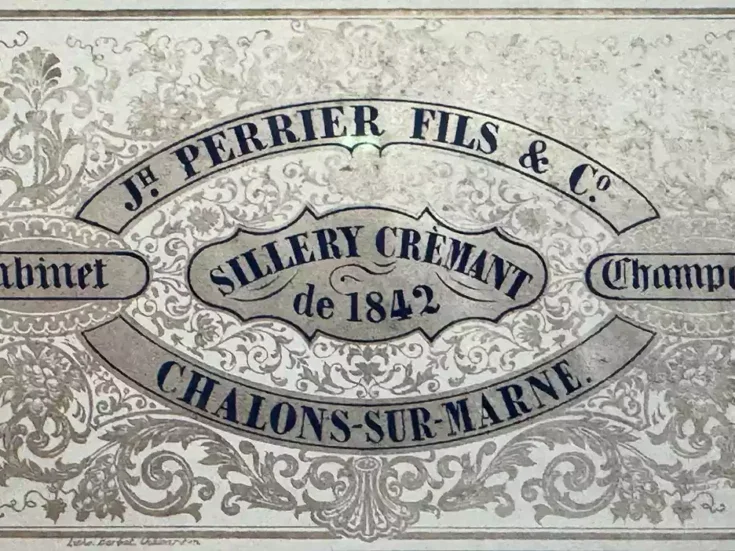
David Williams introduces a high-scoring, fascinatingly instructive tasting of Fino and Manzanilla Sherry shared with Simon Field MW and Andrew Jefford.
Accounts of Sherry’s recent fortunes almost always default to the melancholic and the elegiac—a Death in Jerez story in which a dwindling band of faded, sickly bodegas have found themselves stranded at the far southwestern edge of Europe, out of favor, out of time, and just about scraping a living from their dwindling family fortunes against a backdrop of slow but inexorable decay in the salty Atlantic air.
The symptoms—collapsed shipments (from a peak of around 170 million liters in the late 1970s, to 25 million liters in 2022) and vanishing vineyards (22,000ha [55,000 acres] at Sherry’s early-1980s peak of plantings; 7,000ha [17,000 acres] today)—are certainly hard to ignore. But without in any way trying to minimize the scale of Sherry’s 50-year drift into obsolescence, other interpretations are available. A rather more optimistic, or at least less fatalistic, way of thinking about the region and its wines is to see Sherry as an example (albeit rather an extreme one) of a common pattern of evolution in the contemporary wine world, a process that, in wine-business jargon, goes by the typically ugly marketing term “premiumization.”
Over the past decade, a consensus seems to have formed in the Sherry trade that it needs to embrace rather than fight this process. There’s a belated understanding that, however difficult and daunting it may be, the region’s future lies in the managed abandonment of the kind of high production, low-value wines with which it once made merry (and which have, at a time of declining global wine consumption and rising production costs, become unsustainable) and a switch of energies and focus toward fostering the kinds of wines that can command a “premium” from more sophisticated, less price-conscious wine drinkers.
Sherry lovers are not naive. We’ve seen too many brightly hyped, mayfly-fleeting “revivals” rise and fall—and looked on knowingly as any number of more or less harebrained and expensive cocktail, celebrity-chef, and tapas-based promotional schemes have failed to stop the rot—to be anything other than skeptical about news of yet another renaissance. But I am not alone in thinking, however tentatively and with however many caveats, that this time is different. As Andrew Jefford, my fellow panelist at this exciting, high-scoring, and fascinatingly instructive tasting, says, “The Sherry scene is now one of diversity, excitement, and unpredictability; a welcome change during my working life, despite the near-decimation of vineyard plantings around Jerez and Sanlúcar.”
Sites of innovation
A great deal of the “diversity, excitement, and unpredictability” Andrew refers to is focused on the driest, lightest styles—Fino and Manzanilla Sherry—where broadly speaking, there have been two forms, or sites, of innovation. The first involves developments in what happens inside the bodegas, the ways in which the complex interactions between blender, barrel, wine, spirit, and the mercurial formation of flor are managed and, no less important, how they are communicated.
As the third member of our panel, Simon Field MW, says, Sherry is (or has been) above all a “wine of process,” and the bodegas have always played with the “multiple variables” available to them: “the length of aging, the scheduling of cultivation, and the timing of bottling and release.” What’s changed, in recent years, is that the bodegas have begun to talk about those variables to Sherry drinkers in new categories and wines named after the historic terminology. Hence the rise to prominence of the unmediated seasonal flor expressions of en rama (Sherry’s equivalent of the live recording); the flourishing of the extra-aged pasadas of Manzanilla; and the emergence of Tio Pepe’s palmas (which take their name from the 200-year-old palma system of chalk marks used to classify levels of quality).
Since 2022, a further variable has been sanctioned by the Sherry Consejo Regulador, with producers of unfortified wines permitted to use the terms Fino and Manzanilla on the label. And that brings us to the other site of recent Sherry innovation: the region’s long-neglected and underappreciated vineyards.
The official acknowledgment of unfortified DO Jerez-Xerés-Sherry Fino and Manzanilla is part of a process that is reminiscent in many ways of developments in Rioja, with smaller producers spending many years lobbying the Consejo, and battling with the larger groups, to reinforce Sherry’s status as a wine—a development that is also visible in the increasing number of “vintage” bottlings. The hope, for Sherry’s burgeoning scene of terroirists, is to rebalance conceptions of what makes for fine Sherry—to make the case that the raw materials, and the places where they are grown, are or can (or should) be as important as the logistical finesse and blending abilities of the region’s winemakers. And the Consejo does seem to be listening, with another landmark change in the 2022 reforms including the readmission into the official DO of a group of once widely planted indigenous grape varieties that had disappeared post phylloxera, meaning that Mantúo Castellano, Mantúo de Pilas, Vejeriego, Perruno, Cañocazo, and Beba join the mainstay Palomino, Pedro Ximénez, and Moscatel.
Tasting Fino and Manzanilla Sherry
No such eclectic varietal exoticism was at play in this tasting of Fino and Manzanilla Sherry, with just one PX amid the Palomino—and in the strictest, vineyard-expressive sense, I don’t think any of the panel had terroir in mind as we tasted, either. What did interest us, however, was terroir in the more capacious “wine of place” definition, and in Sherry, of course, the location of the bodega has a significant role to play in shaping aromas, flavors, and styles. Our scores show a more or less even spread of approbation between the 14 Manzanillas of Sanlúcar and the 11 Finos of Jerez. The latter earned the highest scores and three of the top five places, but as Andrew says, Manzanilla had the greater “width and mutability of expression” and will always charm with what he calls its “marine evocations.”
In terms of styles, I was, I think, rather more taken with the unfortified wines than Andrew and Simon, who liked rather than loved them. But they seem to me to be one of the more exciting developments in recent Spanish wine, a distinctively Atlantic style of dry white wine that combines the savory-saltiness and flavory intensity of classic dry Sherry with a youthful levity and energy. That the best were in no way diminished or overwhelmed by being tasted amid a run of much more powerful fortified wines is itself a recommendation of sorts; there is, in any case, remarkable intensity in wines of such scant alcohol. I would love to see more.
Unanimity returns with the en rama bottlings, which again proved they are no mere marketing initiative, with consistently high scores for wines that really do seem to have an extra dimension of raw “flor power”: more substantial, more expressive, more alive. But this was a tasting that was filled with thrilling reminders of dry Fino and Manzanilla Sherry’s continued relevance; enough to underscore the panel’s hope that, in Andrew’s words, “this scene is now viable and enduring.”
The top five: The best of Fino and Manzanilla Sherry
Osborne La Honda Fino en Rama (16% ABV; 50cl) |94
SF | Generous, rich gold color, Titian armor in the sun. Lovely nose of walnut, fig, and bacon rind; umami and vestigial fruit do battle over the pickings of autolytic splendor. Impressive concentration and focus; age shall not wither this eloquent statement of timeless splendor. Nor vainglorious descriptors, their short spell soon forgotten in the face of such irrepressible quality. | 95
AJ | Deep gold. Tangy, rich, just slightly heavy, with plenty of shoulder; missing a little of the diagnostic freshness. With time in the glass, this improves, and after 30 minutes there is better lift and charm, though the fatness beneath still disconcerts. Ditto on the palate. But really this is a Fino well on the way to being a Fino-Amontillado, so it needs to be seen in that light. Of course, it won’t have the same freshness—but one sip just drills down and through the tongue and then comes back up again and sits there for a minute or more, glowing and unshackling. You won’t find the same fresh, textural yeast elements, but it has extraordinary, driving, shattering concentration and pungency. Unique, ferocious; an essential waymark in the wine world. 2024–25. | 92
DW | Enchanting creamy complexity, with vanilla, coffee, and darkly roasted nuts, so complete and harmonious on the palate, with a surge of creamily textured flavor. Butter of both the traditional, salted, dairy kind and the more modern nut-based variety, and a long, all-embracing, comforting finish to a wine of glorious richness and harmony. 2024–25. | 96
Tio Pepe Tres Palmas Fino Jerez de la Frontera [bottled 2023] (16% ABV; 50cl) |94
SF | Attractive, soft gold color, a nacreous infinity pool of potential at the rim. The nose combines savory elements, with hints of yeast, fig, and menthol. Less intense mid-palate than some, this is nonetheless a statement of enviable elegance, its gilded appeal marked by mid-palate generosity and a fine, measured authority on the finish. | 92
AJ | Full gold. Fresh, lively, but a slightly less thickly populated aroma than the best of its peers. Another driving, Fino-Amontillado style, so it needs to be seen in a different light. Okay, you won’t get the same aromatic intrigue that you get with the youngsters, but the compensation is that you get these depth-charge palates that endure for a minute or more and completely recalibrate your mouth-parameters as they do so. This isn’t quite as tensile as [the Osborne La Honda Fino en Rama], but it is every bit as long and maybe longer. Maybe breadier and more flor-rich, too; [Osborne La Honda Fino en Rama] runs more on its lean and scouring acid streak. But it also has a finer aromatic profile. 2024–25. | 95
DW | Iodine and almonds; as so often in this tasting, the descriptors for this Fino sound a little jarring and unappetizing on paper. But again as so often in this tasting, this is a wine of immense character, complexity, interest, and intensity, with a ravishingly silky texture and a lingering, yeasty-tangy finish that keeps you coming back for more. 2024–25. | 94
Barbadillo Manzanilla Pasada Solear en Rama Sanlúcar de Barrameda [bottled winter 2023] (15% ABV; 37.5cl) |93
SF | Pale gold. The nose is informed by the profile of the dusty bodega and barrel as much as by the yeasty machinations therein. A rich, resonant aromatic, contemplative wine, with notes of white tobacco, iodine, and winter flowers all evidenced, one’s animation more than justified by the richly allusive spectral voices from the palate. Dry and yet unerringly complex, the rigors of the solera are less evidenced than on the aromatic, the workings of the yeast therefore to the fore. What a piece of work this is. | 96
AJ | Mid- to deep gold. Strange, but all of the wines in the first flight of Manzanilla look deeper in color than I remember Manzanilla formerly looking. Slower sales, so the wines are sitting longer in their soleras? Or were wines formerly color-filtered? Or some other explanation? Classic flor aromas, with ample nut, apricot, umami in frank and straightforward style. Pure, classical, and driving, though to me this is clearly a Pasada style rather than Manzanilla—as, indeed, are all the wines in this first clip of Manzanilla. (I understand after enquiry that many are Pasada, though this hasn’t been noted on the crib sheet.) Very good, very classical, very true, very pure, very long as such—spot on. If something is this good in (very lightly) fortified form, I can’t really see why you would want to skip that stage. Nothing exhausting here at all, and every glass would beckon another. 2024–25. | 93
DW | Rich, slightly honeyed, completely engaging nose and palate, with fragrances of a dark, shady, Andalusian warehouse: coffee, nuts, golden sultanas. Salty green olives and an olive-oiliness of texture, too, but with life and zip and saline refreshment. 2024–25. | 90
Equipo Navazos La Bota 120 de Manzanilla Pasada Sanlúcar de Barrameda [bottled September 2023] (16.5% ABV; 50cl; SC) |93
SF | Intense golden color, iridescent and polished. A very refined leathery nose, with walnuts, biscuit, and hints of charcuterie in support. This example boasts the idiosyncrasies of age and yet, at the same time, a rigorous and elegant definition of flavor, which signals awareness of the requirements of the market. The best of both worlds, therefore, though some may decry the lack of rustic charm. No matter; there is charm aplenty here, an elegant, elegiac statement of what is possible in this most exceptional of environments. | 93
AJ | A frankly deep medium-gold, turning light into bars and slabs in the glass’s glints. Soft, sweet, warm, promising but barely developed, a kind of embryo Manzanilla aroma; it’s amazing how variable the style can be. Lots of grain and caress here, but little you could call “pungent.” Similarly stealthy and invasive on the palate, but then you discover it has higher acidity than its peers, which comes as a surprise. In the end, it’s “fruitier”—that’s the best way of putting it, remembering always that “fruit” for this style and place means lemons and limes. But I don’t know why this should be. An almost juicy Manzanilla, with lots of bubbling sea-foam energy. I like this a lot. And again, well done that screwcap. 2024–25. | 92
DW | A beguiling richness of bakery aromas and tangy olive-oil scents and viscosity of texture. This has a lovely, creamy intensity, with a salted, grilled-grapefruit tanginess cleaning and lifting the long finish. 2024–25. | 94
Equipo Navazos I Think Manzanilla en Rama Sanlúcar de Barrameda [bottled May 2023] (15% ABV; 37.5cl; SC) |93
SF | A hint of amber, albeit a little watery at the rim. A slightly troubled nose, a little plastic and vegetal, lacking the purity of definition of the best examples: hints of flowers that have just passed their peak, an autumnal mood thereby evinced, far too early for such a recent (spring) bottling. The palate is more interesting, marking this out as an example from the more savory (almost biscuit) camp, so maybe its late bottling, unfiltered, has provoked both the inherent complexity and the charming blemishes of modest imperfection. | 91
AJ | Another wine at the deeper end of mid-gold. Some raisiny fruit, as well as delicate flor. Quite a mixed aroma; there are some floral notes, too. A touch gingery. Wandering off its classical line but doing so entertainingly. Sweeter appeal than many of its peers. Some may feel it’s kind of “overripe”… Oh, gosh—very concentrated here, and wow! A few seconds on the tongue, and you suddenly have a kind of bread explosion under way, a festival of celestial yeastiness. Astonishing and spectacular, not at all what you’d expect from the aroma. There is freshness, too, and lightness (torpid pears note). This is a Manzanilla that knows how to spin across a dancefloor and go outside and pick lemons. Totally wonderful, lovely, unique drink. And it isn’t going to cost white-Burgundy money, either. Yum! (Saco from last May, so the screwcap has done it proud.) 2024–25. | 93
DW | Lots of flor power here: a big hit of grilled-almond and rye-bread bakery scents. All very harmoniously delivered on a palate with drive and succulence and olive-oil glide, then a lingering, tangy, fresh finish. 2024–25. | 94






